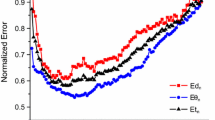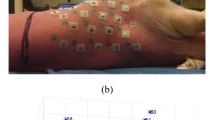Abstract
Purpose
We aimed to identify the electrical stimulation sites of pacemaker leads using a tissue tracking method of tissue Doppler imaging.
Methods
The study group consisted of 30 patients who had undergone permanent pacemaker implantation. During tissue Doppler imaging, the initial contraction site was seen as a red area stimulated by the pacemaker lead. This red area was analyzed precisely using time–distance curves generated by tissue tracking.
Results
The initial contraction site of the myocardium was located in the interventricular septum in seven patients and in the apical portion of the right ventricle in 11 patients. Furthermore, analysis of time–distance curves demonstrated that one point within the red area started to move earlier than the others.
Conclusion
The site of electrical stimulation within the myocardium can be determined from the time–distance curves generated by the tissue tracking method.
Similar content being viewed by others
References
LH David PZ Douglas (2004) Cardiac pacemakers and cardioverter-defibrillators LH David PZ Douglas (Eds) Braunwald's Heart Disease EditionNumber7th edn. Saunders Philadelphia, W.B 767–802
MR Mehra BH Greenberg (2004) ArticleTitleCardiac resynchronization therapy J Am Coll Cardiol 7 1145–8
P Sogaard H Egeblad AK Pedersen et al. (2002) ArticleTitleSequential versus simultaneous biventricular resynchronization for severe heart failure. Evaluation by tissue Doppler imaging Circulation 106 2078–84 Occurrence Handle10.1161/01.CIR.0000034512.90874.8E Occurrence Handle12379577
S Kobayashi T Hayashi M Minai et al. (2002) ArticleTitleGenesis of tricuspid regurgitation after implantation of permanent pacemaker J Cardiol 40 IssueIDSuppl 1 360
K Takenaka Y Kuwata M Sonoda et al. (2001) ArticleTitleAnthracycline-induced cardiomyopathies evaluated by tissue Doppler tracking system and strain rate imaging J Cardiol 37 129–32 Occurrence Handle11433816
A Heimdal A Stoylen H Torp et al. (1988) ArticleTitleReal-time strain rate imaging of the left ventricle by ultrasound J Am Soc Echocardiogr 11 1013–9
AC Borges D Kivelitz T Walde et al. (2003) ArticleTitleApical tissue tracking echocardiography for characterization of regional left ventricular function: comparison with magnetic resonance imaging in patients after myocardial infarction J Am Soc Echocardiogr 16 254–62 Occurrence Handle12618734
S Urheim T Edvardsen H Torp et al. (2000) ArticleTitleMyocardial strain by Doppler echocardiography. Validation of a new method to quantify regional myocardial function Circulation 102 1158–64 Occurrence Handle1:STN:280:DC%2BD3cvls1Klsw%3D%3D Occurrence Handle10973846
M Belohlavek C Pislaru RY Bae et al. (2001) ArticleTitleReal-time strain rate echocardiographic imaging: temporal and spatial analysis of postsystolic compression in acutely ischemic myocardium J Am Soc Echocardiogr 14 360–9 Occurrence Handle1:STN:280:DC%2BD3MvosVejsw%3D%3D Occurrence Handle11337681
L Hanekom V Lundberg R Leano et al. (2004) ArticleTitleOptimization of strain rate imaging for application to stress echocardiography Ultrasound Med Biol 30 1451–60 Occurrence Handle10.1016/j.ultrasmedbio.2004.08.026 Occurrence Handle15588956
M Uematsu K Miyataka N Tanaka et al. (1995) ArticleTitleMyocardial velocity gradient as a new indicator of regional left ventricular contraction: detection by a two-dimensional tissue Doppler imaging technique J Am Coll Cardiol 26 217–23 Occurrence Handle10.1016/0735-1097(95)00158-V Occurrence Handle1:STN:280:ByqA3Mfjs1c%3D Occurrence Handle7797755
JK Kasprzak P Lipiec J Drozdz et al. (2004) ArticleTitleReal-time three-dimensional echocardiography: still a research tool or an imaging technique ready for daily routine practice? A pilot feasibility study in a tertiary cardiology center Kardiol Pol 61 314–5
TI George VS Sachdev AD Zetts et al. (2001) ArticleTitleQuantification of aortic regurgitation by real-time 3-dimensional echocardiography in a chronic animal model: Computation of aortic regurgitant volume as the difference between left and right ventricular stroke volumes J Am Soc Echocardiogr 14 1112–8
Author information
Authors and Affiliations
Corresponding author
Additional information
A summary of this paper was presented at the 77th Conference of the Japan Society of Ultrasonics in Medicine (Tochigi, April 2004)
About this article
Cite this article
Kobayashi, S., Hayashi, T., Akiya, K. et al. Identification of stimulation site of pacemaker lead using tissue tracking method. J Med Ultrasonics 33, 23–28 (2006). https://doi.org/10.1007/s10396-005-0083-6
Received:
Accepted:
Issue Date:
DOI: https://doi.org/10.1007/s10396-005-0083-6




